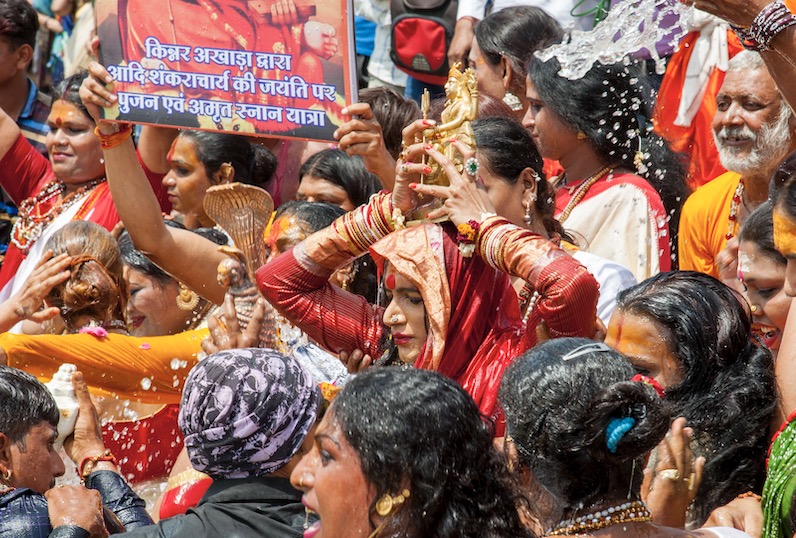ARUN MISHRA
Sacred celebrations: Devotees perform Kshipra arati at Ram Ghat in the evening
FESTIVALS
THE 2016 UJJAIN KUMBHA MELA: A GALLERY
______________________
Photographer Arun Mishra captures the spirit of the Mela
______________________
BETWEEN APRIL 22 AND MAY 21 OF 2016, nearly 75 million people made their way to the ancient Indian city of Ujjain to take part in this year’s Kumbha Mela. Ujjain, located on the banks of the Kshipra River in the western region of Madhya Pradesh, is one of the most sacred cities in India. Its Mela is one of four that are held during each 12-year period. The other three take place at Haridwar, Prayag (Allahabad) and Nasik.
Millions of devotees from all around India and the world attend these massive events, including thousands of renunciates, sadhus and other holy people. Present at each Kumbha Mela are the various akharas—India’s traditional monastic schools, seven of which are said to have been founded by Adi Shankaracharya in the 8th century. Many devotees make the pilgrimage just to interact with these renunciates.
The big event at the Kumbha Mela is the main bathing day, the Shahi Snan. It commences with a grand parade to the river banks by the sadhus for their snan (sacred bath). After the sadhus have bathed, the general population enter the river for their holy dip. This event, held on full moon day, is the largest of several official bathing days throughout the month.
This year’s Shahi Snan was unique; it was the first time that the saints and Naga ascetics of the 13 Saivite and Vaishnavite Akharas agreed to take the bath simultaneously, instead of vying for first place as in past years. In this way they affirmed the ideal of peaceful coexistence between philosophical views.
The all-female Juna Sannyasini Akhara, though allocated its own facilities for participation in the 2013 Kumbha Mela in Allahabad, was not permitted at the 2016 Ujjain Mela. However, this Mela saw the initiation of over 400 women monks in the Naga order.
Also this year, the transgender community was allotted five acres of land to host the Kinnar Akhara. Formed in October of 2015, the Kinnar Akhara is a religious school of transgenders that now has branches in over two dozen states. The unexpected inclusion of a transgender akhara met with some objections from other akharas. However, the Kinnar Akhara’s positive reception by attending pilgrims testified to their overall acceptance, as did their treatment as holy people; they enjoyed the full respect afforded to any Hindu sadhu. Not allowed to take part in the main parade with the other akharas, the Kinnar Akhara held its own parade to the river for their sacred dip.
ARUN MISHRA
One of thousands of naga sadhus going for Shahi Snan
ARUN MISHRA
Laxmi Narayan Tripathi, head of the Kinnar Akhara, bathes in the Kshipra along with other members of the Akhara, while holding a statue of Goddess Devi over her head
ARUN MISHRA
A pilgrim holding a diya lamp honors the Kshipra River
ARUN MISHRA
Newly initiated naga sadhus sit together after their initiation
In total, this year’s event was spread over 9,000 acres and was the result of four years of planning by the Madhya Pradesh government, which allocated US$500 million for it. Additional funds were provided by the Central Government and other agencies. Nearly 100 roads and 14 bridges were constructed in and around Ujjain to accommodate the high volumes of pilgrims, resulting in a nice upgrade to Ujjain’s infrastructure.
Early in the event a lightning strike took the lives of six people and injured another 40. But otherwise—aside from a leaky sewage system—most pilgrims had a positive experiences. In response to some reports of poor facilities, photographer Rishika Baruah stated in an article at thequint.com, “I spent an evening at the Kumbh on the eve of the Shahi Snan, when the footfall was supposedly one of the highest. Contrary to popular public perception, it’s not all that bad. The ghats of the Kshipra were clean, the water was being oxygenated and the area to take a dip was well marked. There were plenty of clean mobile toilets and changing enclosures. The parking areas were easily accessible by hand-pulled carts or e-rickshaws for those who did not wish to walk, and there was plenty of accommodation within the Kumbh enclosures.”
ARUN MISHRA
A day at the Mela: A young naga sadhu bathes in the river Kshipra during the shahi snan
ARUN MISHRA
Swami Rajendra Dasji performs a havana
ARUN MISHRA
Each of the akharas serve food every day to pilgrims at the Kumbha Mela
ARUN MISHRA
Women perform a ritual for the well-being of their families before taking a bath in the river
ARUN MISHRA
Devotees perform an evening arati at the river
ARUN MISHRA
Worship at the river’s edge: During the day of the Shahi Snan devotees flock to the Ram Ghat for their sacred bath
ARUN MISHRA
A naga sadhu blows a conch shell in celebration during the main bathing day
ARUN MISHRA
Statue of Sri Chitragupta, the God said to be assigned with the task of keeping complete records of actions of human beings on the earth
